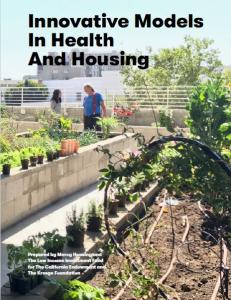
Author: oshua Bamberger, Rachel Bluestein, Kim Latimer-Nelligan, Richard Samson, and Doug Shoemaker
Publication Year: 2017
Media Type: Report
Summary:
This report aims to bridge a knowledge gap between the affordable housing and healthcare fields that limits their ability to implement health and housing projects and partnerships. These two sectors have begun to realize how much they overlap, but while great work has been done to expose practitioners in both fields to information about their shared interests and common goals, the results to date have been relatively modest. [Executive Summary p. 4]
Abstract:
This report aims to bridge a knowledge gap between the affordable housing and healthcare fields that limits their ability to implement health and housing projects and partnerships. These two sectors have begun to realize how much they overlap, but while great work has been done to expose practitioners in both fields to information about their shared interests and common goals, the results to date have been relatively modest.
Many healthcare organizations see affordable housing as critical to the health needs of their patients and plan members, but don’t know how to support the creation of housing and help them secure it. Many housing developers see that providing safe, affordable, and high quality housing to high-need individuals could deliver significant value to health partners, but aren’t sure how to structure a partnership with the relevant health agencies. This document provides examples of how various healthcare and housing stakeholders have worked together to take advantage of the strengths of each sector to overcome the constraints that limit successful collaboration.
This report outlines nine case studies drawn from around the country, where the healthcare and affordable housing sectors have worked collaboratively to expand housing opportunities targeted toward individuals whose health conditions would significantly improve from service-enriched affordable housing. While acknowledging the challenges of working across sectors, and the constraints on using healthcare funding to improve the “social determinants” of health, these case studies show that there is significant opportunity to produce tangible results that improve the lives of homeless people, people living with poverty, and people living in institutions. Some of the case studies show that through coordinated statewide government legislation, healthcare funding can be used as a catalyst to expand housing stock (e.g. Minnesota, Developmental Disability in California). We also document how focused investments from managed care agencies developed housing alternatives for people living in institutions and suffering from homelessness (e.g. San Mateo, Central California Alliance for Health) and how hospitals can use their Community Benefits Obligation to expand housing stock (e.g. Central City Concern). Three of the cases focus on providing community alternatives to institutional care (e.g. HPSM, Ohio, Developmental Disability in California) and lastly we document two communities in California (San Francisco and Los Angeles) that have used considerable local resources combined with political will to expand both scattered site and project-based housing targeting chronically homeless adults who are high users of the healthcare system.
In each of the studies presented, we try to outline how the projects developed and detail the housing and financial systems that allowed the cross-sector collaboration to become a reality. While each case is unique, one common attribute across each of the sites stands out: it required a strong leader committed to the vision that housing is an effective healthcare treatment. As Atul Gawande writes in the New Yorker, the healthcare system was designed to “put out fires” rather than foster incremental change to improve chronic conditions. In this report we hope to show that the healthcare sector, through an investment in housing, can improve the health of a community. We also hope to show that the affordable housing sector can prioritize housing to individuals at greatest concern to the healthcare sector. While the barriers to progress may be many, these cases show that with strong vision and a common purpose, there are many solutions as well. [Executive Summary p. 4]
Arts & Intersections: Housing
Categories: Housing, Community Development
ADDITIONAL BIBLIOGRAPHICAL INFORMATION
PUBLISHER INFORMATION
Name:
Website URL: